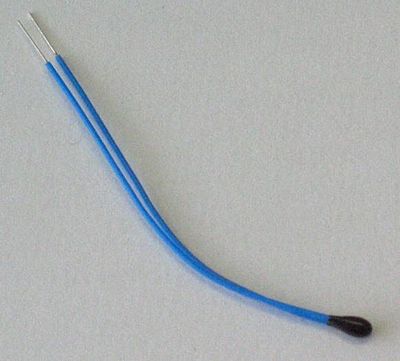Bilgiler > NTC and PTC (english)
NTC and PTC (english)

NTC & PTC
A thermistor is a type of resistor whose resistance is dependent on temperature, more so than in standard resistors. The word is a portmanteau of thermal and resistor. Thermistors are widely used as inrush current limiter, temperature sensors (Negative Temperature Coefficient or NTC type typically), self-resetting overcurrent protectors, and self-regulating heating elements (Positive Temperature Coefficient or PTC type typically).
Thermistors are of two opposite fundamental types:
With NTC thermistors, resistance decreases as temperature rises. An NTC is commonly used as a temperature sensor, or in series with a circuit as an inrush current limiter.
With PTC thermistors, resistance increases as temperature rises. PTC thermistors are commonly installed in series with a circuit, and used to protect against overcurrent conditions, as resettable fuses.
Thermistors differ from resistance temperature detectors (RTDs) in that the material used in a thermistor is generally a ceramic or polymer, while RTDs use pure metals. The temperature response is also different; RTDs are useful over larger temperature ranges, while thermistors typically achieve a greater precision within a limited temperature range, typically -90 °C to 130 °C.[1]
NTC
Many NTC thermistors are made from a pressed disc, rod, plate, bead or cast chip of semiconducting material such as sintered metal oxides. They work because raising the temperature of a semiconductor increases the number of active charge carriers - it promotes them into the conduction band. The more charge carriers that are available, the more current a material can conduct. In certain materials like ferric oxide (Fe2O3) with titanium (Ti) doping an n-type semiconductor is formed and the charge carriers are electrons. In materials such as nickel oxide (NiO) with lithium (Li) doping a p-type semiconductor is created where holes are the charge carriers.
PTC
Most PTC thermistors are made from doped polycrystalline ceramic (containing barium titanate (BaTiO3) and other compounds) which have the property that their resistance rises suddenly at a certain critical temperature. Barium titanate is ferroelectric and its dielectric constant varies with temperature. Below the Curie point temperature, the high dielectric constant prevents the formation of potential barriers between the crystal grains, leading to a low resistance. In this region the device has a small negative temperature coefficient. At the Curie point temperature, the dielectric constant drops sufficiently to allow the formation of potential barriers at the grain boundaries, and the resistance increases sharply with temperature. At even higher temperatures, the material reverts to NTC behaviour.
Another type of thermistor is a silistor, a thermally sensitive silicon resistor. Silistors employ silicon as the semiconductive component material. Unlike ceramic PTC thermistors, silistors have an almost linear resistance-temperature characteristic.[5]
Barium titanate thermistors can be used as self-controlled heaters; for a given voltage, the ceramic will heat to a certain temperature, but the power used will depend on the heat loss from the ceramic.
The dynamics of PTC thermistors being powered also is extremely useful. When first connected to a voltage source, a large current corresponding to the low, cold, resistance flows, but as the thermistor self-heats, the current is reduced until a limiting current (and corresponding peak device temperature) is reached. The current-limiting effect can replace fuses. They are also used in the degaussing circuits of many CRT monitors and televisions where the degaussing coil only has to be connected in series with an appropriately chosen thermistor; a particular advantage is that the current decrease is smooth, producing optimum degausing effect. Improved degaussing circuits have auxiliary heating elements to heat the thermistor further (and reduce the final current) or timed relays to disconnect the degaussing circuit entirely after it has operated.
Another type of PTC thermistor is the polymer PTC, which is sold under brand names such as "Polyswitch" "Semifuse", and "Multifuse". This consists of plastic with carbon grains embedded in it. When the plastic is cool, the carbon grains are all in contact with each other, forming a conductive path through the device. When the plastic heats up, it expands, forcing the carbon grains apart, and causing the resistance of the device to rise, which then causes increased heating and rapid resistance increase. Like the BaTiO3 thermistor, this device has a highly nonlinear resistance/temperature response useful for thermal or circuit control, not for temperature measurement. Besides circuit elements used to limit current, self-limiting heaters can be made in the form of wires or strips, useful for heat tracing. PTC thermistors 'latch' into a hot / high resistance state: once hot, they stay in that high resistance state, until cooled. In fact, Neil A Downie showed how you can use the effect as a simple latch/memory circuit, the effect being enhanced by using two PTC thermistors in series, with thermistor A cool, thermistor B hot, or vice versa.[6]
***
Telefon Uyumlu Sayfa